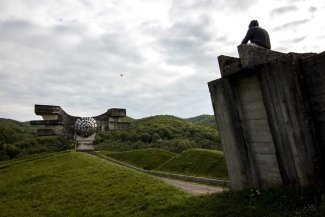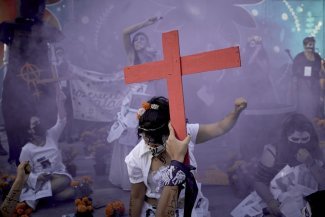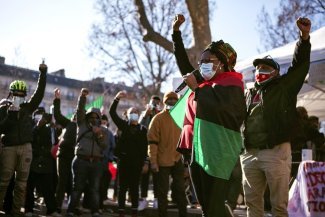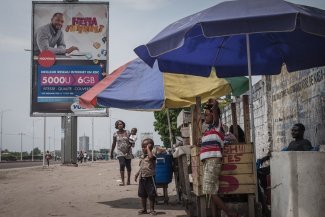At the Ibn-e Baabevey cemetery in the town of Rey in Greater Tehran lies a broken memorial stone for Mohammad Mossadegh. On 19 July 1980, during the only official ceremony that has ever been held at his empty grave, a three-metre-high memorial was installed in Ibn-e Baabevey with Mossadegh’s name carved on it in Farsi calligraphy. However, the memorial only stood in place for one week before it was broken by Islamists.
Locals call it ‘The Fortress’ because of the three-metre-high metal gate guarding the entrance, which has hardly been opened in recent years. But the site is best known as Mohammad Mossadegh’s ancestral estate, located in the heart of the tiny village of Ahmad Abad, 120 kilometres from Tehran, and as his final resting place. Mossadegh was Iran’s first democratically elected prime minister, but after less than two years in power his government was toppled in a 1953 coup. Against his wishes, his body is buried in the living room of his family’s two-story mansion. No one is allowed to visit.
“If you want to see the mansion, go to the other side of the fortress,” says a girl in her early twenties running a small grocery shop close to the entrance gate. “Part of the mud wall is shorter over there. Stand on a small bump and you can see what’s behind the wall.” She also offers a warning: “Be fast. If the police come, you will be in trouble.”
Fifty-three years after his death, Mossadegh’s name (which is also spelt Mossadeq) is still taboo in Iran. No one can visit his grave and there are no standing statues or monuments dedicated to him. This erasure is a stark contrast to the popularity Mossadegh enjoyed when he was appointed prime minister in April 1951 after leading the oil nationalisation movement in Iran’s parliament (the Majlis).
After the Majlis passed legislation to nationalise Iran’s oil industry in March 1951, just before Mossadegh came to power, he became a national hero for attempting to end “150 years of British political interference, economic exploitation and plundering of Iran’s national resources,” according to The Mohammad Mossadegh Project, a website set up in his memory.
He is still a highly respected figure amongst ordinary Iranians, however, neither the monarch who ruled Iran before the 1979 revolution, nor the current theocrat rulers of the country have ever acknowledged his pivotal role in Iran’s modern history. “During the time of the Shah [Iran’s last king, whose authoritarian and secular rule lasted from 1941 to 1979] he was controversial, especially with the monarchists, because he was so popular,” explains Professor Mark J. Gasiorowski, a professor of political science at Tulane University and co-editor of the 2004 book Mohammad Mosaddeq and the 1953 Coup in Iran. “The leftists didn’t like him, because he was too moderate for them. And since the [1979] revolution most Islamists don’t like him either,” he adds.
Today Mossadegh is the subject of renewed attention thanks to the parallels that can be drawn between the devastating sanctions that the US has imposed on Iran’s oil exports since 2018 and the embargos that paralysed Iran’s economy following the nationalisation of the country’s oil industry in 1951. “Once again Iran’s internal political development is being thwarted by the policies of the Great Powers,” Professor Nader Hashmi, director of the Center for Middle East Studies at the University of Denver’s Josef Korbel School of International Studies, tells Equal Times. “In 1953, it was the British who put an economic blockade on Iran and supported the CIA coup that ended Iran’s nascent experiment with democracy. Today it is United States, with critical support from Israel, Saudi Arabia and the UAE, who are seeking regime change in Iran,” he adds.
The first of many US-backed coups
Since the 1908 discovery of oil in Iran, the Anglo-Persian Oil Company – of which the British government had a majority share – had controlled the drilling, extraction and sale of Iran’s oil. Iranian nationalists had been fighting for the nationalisation of the oil industry since the early 1940s, however, the influence of the British government on the last king of Iran, the Shah, had obstructed those attempts.
The Shah came to power with direct support from the British government, and Mossadegh’s rise to power in 1951 was the only time when the Shah’s Western-backed dictatorship faced a serious democratic challenge. However, two years later, on 19 August 1953, Operation Ajax was carried out in Tehran and Mossadegh’s government was overthrown in a violent coup financed and planned by the CIA and MI6, the US and British intelligence agencies, and which resulted in scores of deaths. Mossadegh was tried for treason and some of his followers were arrested, tortured, imprisoned and even executed.
Operation Ajax was the CIA’s first major success, since its creation in 1947, in overthrowing a sovereign government that was not aligned with US interests.
It also opened a bloody new chapter in US foreign policy, which saw the orchestration of coups and the toppling of democratically elected leaders all across the world, from the removal of Guatemala’s Jacobo Árbenz in 1954, Congo’s Patrice Lumumba in 1960 and Chile’s Salvador Allende in 1973 to the installation of Hissène Habré as president of Chad in 1982 and the destabilisation of Iraq throughout the 1990s, along with countless other examples.
As a result of the coup, Mossadegh served three years in solitary confinement followed by 10 years under house arrest until his death on 5 March 1967. However, even the angel of death could not free him from his internment.
Empty grave
Mossadegh had wanted to be buried in Ibn-e Baabevey, a historic cemetery in the town of Rey, next to 25 unsung Iranians whose identical gravestones share the inscription ‘Martyr of the Homeland’. The 25 men were Mossadegh supporters who died in an uprising known as Si-e-tir, which broke out after Mossadegh resigned on 16 July 1952 under pressure from the Shah. As a result of the protests, in which demonstrators rallied around the slogan “Give me death or give me Mossadegh!” Mossadegh returned to power just five days later, until he was finally overthrown in March 1953. However, his wish to be buried alongside his martyred supporters remains unfulfilled.
The last king of Iran never permitted the dead body of his enemy leave ‘The Fortress’, while those who came to power after the 1979 revolution have followed the same policy.
According to Professor Hashemi, followers of the Ayatollah Ruhollah Khomeini, Iran’s first supreme leader, have framed their animosity against Mossadegh based on post-revolutionary identity politics.
“Political Islamists who were loyal to Khomeini were battling for hegemony and state control with various Marxist and socialist organisations, and secular and religious nationalists that supported the Iranian revolution,” Hashemi says. “In this context, Mossadegh was viewed by Khomeini and the Islamists as a secularist and insufficiently religious, even though he was a practicing Muslim.”
Abdol-Madjid Bayat Mossadegh, the 95-year-old grandson of the toppled premier, says that his family still live in hope that he can be taken to his final resting place. “The burying place in Ibn-e Baabevey has been ready for him all these years. The earth is ready to take in his body, but no one lets this happen,” adds Bayat Mossadegh, who runs the Mossadegh Foundation in Geneva, a not-for-profit organisation which celebrates the legacy of Mohammad Mossadegh and Iran’s rich heritage.
Traitor or hero
According to the official narrative peddled by Iranian authorities, Mossadegh’s misplaced trust in the promises of the US government to mediate between Iran and the UK following the nationalisation of the oil industry in 1951 and to provide monetary support to Iran’s troubled economy during the embargo led the oil nationalistaion movement to a deadlock – and ultimately to failure. After the coup, the National Iranian Oil Company became an international consortium, of which the Anglo-Iranian Oil Company became a member. This allowed Britain and the United States to continue to have a direct influence on Iran’s oil industry until the 1979 revolution.
“It is a gross distortion of the historical record to blame the 1953 coup on this alleged fact,” Hashemi tells Equal Times. “New documentation has emerged that reveals the CIA’s financial support for various senior clerics in Iran in 1953 to mobilise [them] against Mossadegh. This is a fact that the Islamic Republic refuses to admit for ideological reasons.”
Since the 1953 coup, generation after generation of ordinary Iranians have fantasised over what would have happened to their country if Mossadegh’s short-lived democratic government was not toppled by the West. In a similar manner today, people also ask themselves what would have happened if the US has not violated the 2015 Joint Comprehensive Plan of Action (JCPOA).
In 2015, following eight years of devastating sanctions on Iran, six world powers and Iran singed the JCPOA agreement to ease decades of sanctions on the country (which began as a result of the US embassy siege in Tehran in 1979), in return for limits on Iran’s nuclear programme. In 2018, however, in a bid to force Iran to abandon its entire nuclear programme, to undermine the legacy of the former US president Barack Obama and to further America’s expansionist aims in the region, US president Donald Trump unilaterally abandoned the accord and imposed harsh sanctions on Iran’s oil exports, banking system, and any foreign companies doing business with Iran.
“The struggle for democracy in Iran has been dependent on a ripe international context,” Hashemi says. “This existed for a brief period during the Obama administration. I believe that if the JCPOA was fully implemented and adhered to, it might have opened doors for democratic organising and mobilisation down the road. It is largely for this reason that Iranian hardliners were strongly against the JCPOA and now are celebrating its demise.”
However, there is a fundamental distinction between Iranian society today and that of seven decades ago. Back then, Mossadegh was under tremendous pressure from all his supporters not to surrender in the fight against imperial powers. Today, exhausted by decades of crippling sanctions, corruption and 41 years of “clerical despotism” as Hashemi describes it, a large part of Iranian society lacks any will to continue this battle.










